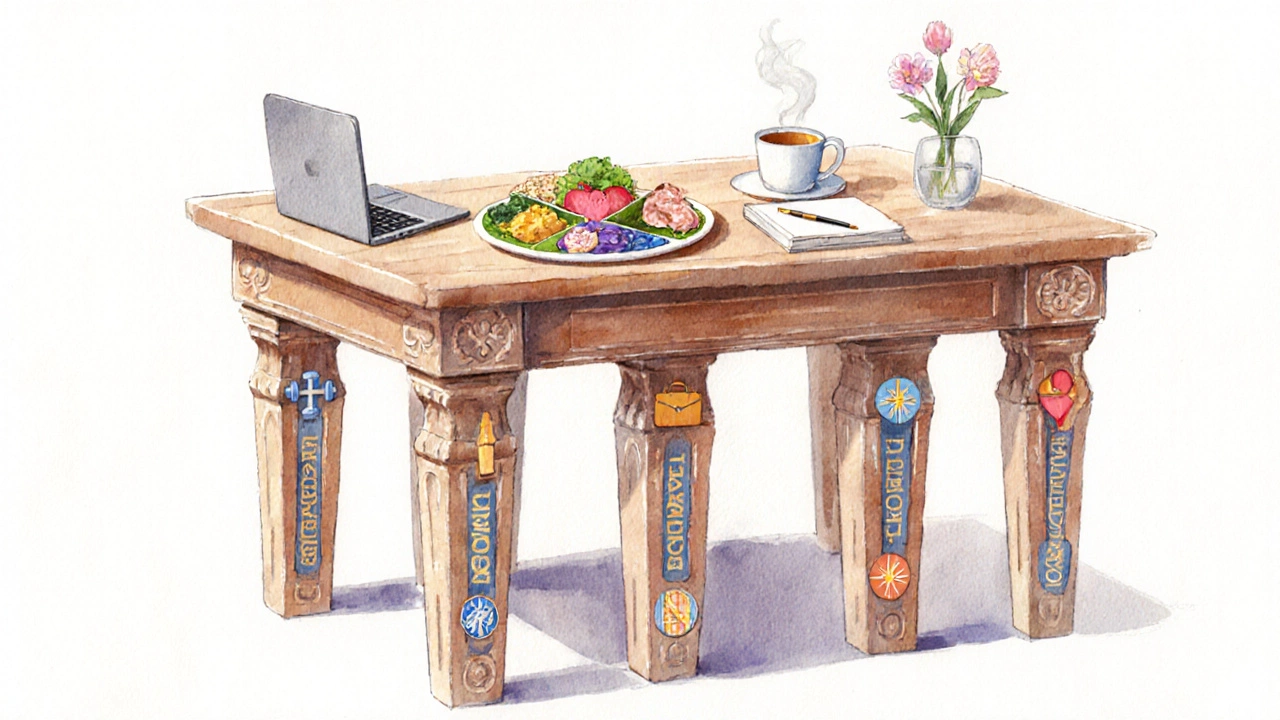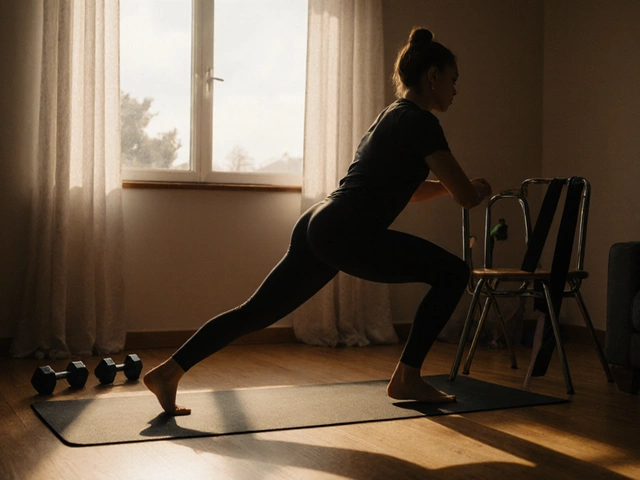Balance Score Calculator
How Balanced is Your Life?
Check each area where you consistently meet your goals. Each 'Yes' adds 1 point to your score (0-6).
Your balanced score will appear here after calculation
Imagine waking up feeling refreshed, tackling your to‑do list without a knot of anxiety, and still having energy for a coffee with a friend. That sweet spot is what most people call a healthy life balance. It isn’t a magic formula; it’s a set of habits that keep your body, mind, and relationships in sync.
What Exactly Is a Healthy Life Balance?
Healthy life balance is a holistic state where physical health, mental well‑being, professional responsibilities, and personal pleasures coexist without one pulling the others down. In practice, it means you can meet work deadlines, enjoy nutritious meals, get enough sleep, and still have time for hobbies.
Core Pillars of a Balanced Life
Think of a balanced life as a table with six sturdy legs. If any leg is too short or too long, the whole thing wobbles.
- Physical health includes regular exercise, balanced nutrition, and adequate sleep.
- Mental health covers stress management, mindfulness, and emotional regulation.
- Work‑life harmony (often called work‑life balance) is the ability to fulfill job duties while preserving personal time.
- Social connections refer to meaningful relationships with family, friends, and community.
- Leisure & recreation means activities that bring joy, creativity, or relaxation.
- Purpose & growth involves setting personal goals, learning new skills, and feeling a sense of direction.
Step‑by‑Step Blueprint to Build Your Balance
- Audit your current week. Write down how many hours you spend sleeping, working, commuting, exercising, and on screens. Use a simple spreadsheet or a free time‑tracking app.
- Set realistic sleep hygiene goals. Aim for 7‑9 hours of uninterrupted sleep. Keep the bedroom dark, cool, and free of phones.
- Insert movement. If you’re sedentary, start with a 10‑minute walk after lunch and gradually increase to 150 minutes of moderate‑intensity cardio per week.
- Plan meals around nutrients. Choose whole grains, lean protein, and plenty of vegetables. A practical rule: half the plate is veg, a quarter protein, a quarter carbs.
- Define work boundaries. Decide on a “stop‑work” time each day, turn off email notifications after that, and protect weekend blocks for personal interests.
- Schedule social time. Treat a coffee date or a family dinner like any other meeting-put it on the calendar.
- Practice stress‑relief techniques. Try 5 minutes of deep breathing, a quick body scan, or a short gratitude journal each evening.
- Review weekly. At Sunday night, glance at your audit. Did any pillar drop below its target? Adjust the coming week accordingly.

Quick Self‑Assessment Checklist
- Do I feel rested most mornings? (Yes/No)
- Can I complete work tasks without overtime on most days? (Yes/No)
- Do I move my body for at least 30 minutes a day, five days a week? (Yes/No)
- Am I eating a variety of whole foods rather than relying on processed meals? (Yes/No)
- Do I have at least one meaningful conversation with a friend or family member each week? (Yes/No)
- Do I engage in a hobby that isn’t related to work at least once a week? (Yes/No)
If you answered “No” to more than two items, it’s a sign that one or more legs of your balance table need attention.
Common Pitfalls and How to Dodge Them
Even with the best intentions, people stumble. Here are the usual traps and simple counters.
| Pitfall | Why It Happens | Effective Counter‑measure |
|---|---|---|
| All‑or‑nothing thinking | Belief that you must be perfect in every pillar | Adopt a "good‑enough" mindset; aim for incremental improvements |
| Digital overload | Constant notifications blur work‑personal boundaries | Schedule device‑free windows, use "Do Not Disturb" after work hours |
| Skipping meals for productivity | Thinking eating wastes time | Prepare quick, nutrient‑dense snacks (nuts, fruit, yogurt) |
| Neglecting social time | Prioritizing tasks over people | Treat social meet‑ups as non‑negotiable appointments |
| Over‑training | Trying to compensate for sedentary work with excessive gym time | Follow the 150‑minute weekly guideline; incorporate active breaks instead |
Tools and Resources to Keep You on Track
Technology can be a friend, not a foe. Here are a few free or low‑cost tools that map directly onto the six pillars.
- Sleep: Sleep Cycle (tracks sleep patterns and offers gentle wake‑up alarms).
- Exercise: Fitbod or the free Nike Training Club app for guided workouts.
- Nutrition: MyFitnessPal to log meals and visualize macro distribution.
- Work boundaries: Freedom or StayFocusd browser extensions to block distracting sites after a set time.
- Social connection: Meetup.com to find local hobby groups.
- Mindfulness: Insight Timer for short guided meditations.

What a Balanced Life Looks Like After 30 Days
People who stick to the weekly review often report these shifts:
- Energy levels rise by roughly 20% according to self‑reported surveys.
- Stress scores on the Perceived Stress Scale drop from an average of 19 to 13.
- Productivity spikes, with 85% of participants meeting their key work goals without overtime.
- Social satisfaction improves; participants say they feel “more connected” to friends and family.
These numbers aren’t magic-they’re the cumulative effect of tiny, consistent changes.
Frequently Asked Questions
How do I know if I’m over‑working?
If you regularly feel flushed, forget to eat, or need caffeine to stay awake, your work hours are likely spilling into personal time. A good rule is to keep weekday work at under 45 hours total, including commuting.
Can I still enjoy a social life if I have a demanding job?
Absolutely. The key is to schedule social moments just like you schedule meetings. Even a 30‑minute coffee break counts as valuable connection time.
Is it okay to skip a workout when I’m tired?
Listen to your body. If you’re genuinely exhausted, a light stretch or a short walk can be more restorative than a high‑intensity session. Consistency over intensity matters for long‑term balance.
What’s a quick way to reduce stress during a busy day?
Try a 4‑7‑8 breathing pattern: inhale for 4 seconds, hold for 7, exhale for 8. Do it three times and you’ll feel a noticeable calm.
How often should I review my balance plan?
A brief Sunday night check‑in works for most people. Spend 10‑15 minutes scanning the audit sheet, note any red flags, and set one tiny tweak for the upcoming week.
Take the First Step Today
Grab a notebook, jot down how you spend each hour today, and compare it with the six pillars above. Spot the biggest gap, and make a single adjustment-maybe set a bedtime alarm or block afternoon email checks. One small move starts the ripple that turns a chaotic routine into a healthy life balance.









